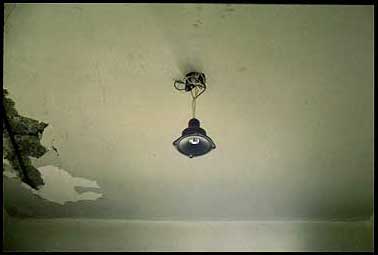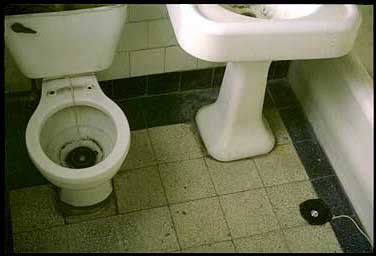 |
MECANISMOS DE ABSOLUCION DE DESHECHOS

Speaker at the entrance hall of the bathroom. San Martín building, México D.F. 1997.
Mechanisms for the absolution of wasteSpeaker at the entrance
hall of the bathroom. San Martín building, México D.F. 1997.Mechanisms
for the absolution of waste is a sound installation that deals with the fluxus
of waste of different densities which our body expels. This expelling act
is related with the final state of a complex process, in which our body works
digesting food by using an enormous amount of energy. The result has a high
degree of entropy, because the matter of waste has less energetic qualities
to be re-transformed and re-used . [1].
The concept of negative entropy, which is opposite to that of entropy, is
related with the information that a system posses, and with the degree of
complexity and heterogeneity of the ordered organization of that system. A
system which has negative entropy needs to have a continuous flux and interchange
of energy, which will enable the maintenance of its structural and complex
state of order. A system such as our living organism has a negative entropy,
in which its parts have the capacity to return to their initial state after
a work cycle, but besides this, these parts can return to an even more integrated,
structured and ordered state. Negative entropy constitutes then the capacity
of the information to produce work, and of increasing the state of order of
a system. Negative entropy in a living entity is gained through the feeding
process, but the result of this process has positive entropy and is of little
utility because its structure contains a minimum of energy.
My idea with this sound installation has been to convert sounds of waste coming
from our body into "musical" sounds. The consciousness of these
sounds and their reorganization in time will produce a fluxus of sound by
which we can accomplish a state of contemplation, which will bring us closer
to the expelling processes of our body, and which are analog to the purification
processes of our mind and spirit. The interesting thing about these "musical"
sounds, is that they are converted into a new feeding source for our ears,
and that the idea of waste doesn’t constitute any more an alienated
entity, but is converted into renewed energy. The entropy result is then converted
into a process of negative entropy, which is heterogeneous, complex and vital.
I used the bathroom of the apartment of the first floor of an abandoned building
(the San Martín building in la colonia condesa, Mexico D.F.). The mechanisms
that exist in a bathroom (the toilet flusher, the sink faucet, etc) produce
fluxus of waste which serve as transport for other products of waste. I placed
a speaker inside the toilet, another one coming out from the shower and another
from the bathtub. These speakers produce sounds of the expelling processes
of human waste. At the same time, I also used the entrance of the bathroom
and placed a speaker instead of the ceiling light bulb, which also produces
these kinds of sounds. To start the sounds of each mechanism, I placed ON/OFF
switches; in this way, the different mechanisms can sound at the same time
or independently.
The advantage of a sound abstraction is that the negative aspects of waste
substances such as smell and appearance are eliminated; also, the sounds are
interesting. On the other hand, the re-structuration of these sounds in time
provoke a space of metaphors where the sound of burping could be regarded
as a watery flux, a piece of excrement falling into the tolet water could
be equivalent to the childish game of throwing stones into a well. Urinating
and burping are in fact games that entertain us. Nevertheless, the interesting
thing about finding qualities in this kind of sounds is to go beyond the games
and to find a state of piece, fluxus and purification; to create with them
an alchemical process and be able to obtain the philosophers stone, with which
we will obtain energetic sounds from the useless sounds of waste coming our
from our body.Speakers in the toilet and in the grill. San Martín building.
México D.F. 1997.

Speaker in the bathtub faucet. San Martín building. México D.F. 1997.

Speaker in the bathtub faucet. San Martín building. México D.F. 1997.
[1] Boltzman established that the entropy of a system increases as its molecular structure reaches its most probable arrangement. A rock that has fallen and stays immobile at the foot of the mountain it is a more probable situation than the previous state in which the rock was about to fall.
MECANISMOS DE ABSOLUCION DE DESHECHOS